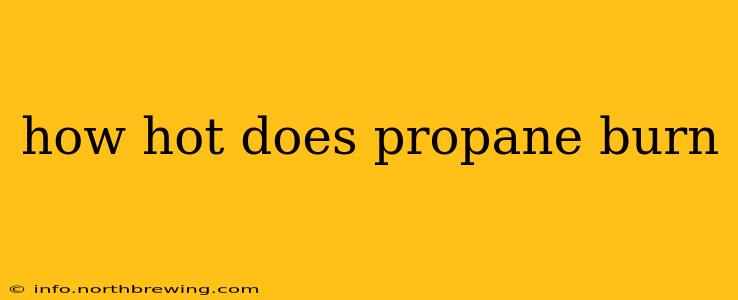Propane, a widely used fuel for heating, cooking, and various industrial applications, burns incredibly hot, making it a powerful energy source. But how hot exactly does it burn? The answer isn't a single number, as the temperature can vary depending on several factors. Let's delve into the specifics and explore the science behind propane combustion.
What is the temperature of a propane flame?
The theoretical adiabatic flame temperature of propane in air is approximately 3,600°F (1,982°C). This is the maximum temperature achievable under ideal conditions, assuming complete combustion and no heat loss to the surroundings. However, in real-world scenarios, this temperature is rarely reached.
What factors affect propane flame temperature?
Several factors influence the actual temperature of a propane flame:
-
Air-to-fuel ratio: The ideal air-to-fuel ratio for complete combustion is crucial. Too much air (lean mixture) lowers the temperature, while too little air (rich mixture) results in incomplete combustion and a lower temperature, producing soot and carbon monoxide.
-
Ambient temperature and pressure: Lower ambient temperatures and higher pressures generally lead to slightly higher flame temperatures.
-
Burner design: The design of the burner significantly affects the mixing of propane and air, impacting the efficiency of combustion and, consequently, the flame temperature. Different burner types will exhibit different temperature profiles.
-
Heat loss: Heat is inevitably lost to the surroundings through radiation, convection, and conduction. The more efficient the heat transfer system (e.g., a well-insulated appliance), the higher the flame temperature.
How hot does propane burn in different applications?
The temperature of a propane flame can vary drastically based on its application:
-
Propane grills: The temperature of a propane grill flame can range from 500°F (260°C) to over 800°F (427°C), depending on the burner configuration and how much propane is flowing. The surface temperature of the grill grates will be lower.
-
Propane furnaces: The temperature of the combustion gases in a propane furnace can reach 1,500°F (816°C) to 2,000°F (1,093°C) or even higher. However, this heat is then transferred to the air that is circulated to warm a home, resulting in a lower output temperature.
-
Propane torches: Propane torches can produce flames significantly hotter than grills or furnaces, reaching temperatures of 2,000°F (1,093°C) to 3,000°F (1,649°C) or more, depending on the design and oxygen supply.
What are the safety considerations of propane combustion?
Because of the high temperatures involved, it's crucial to handle propane safely. Always follow manufacturer's instructions and take necessary precautions, including:
- Proper ventilation: Ensure adequate ventilation to prevent the buildup of carbon monoxide.
- Leak detection: Regularly check for leaks using soapy water.
- Fire safety: Keep a fire extinguisher nearby and know how to use it.
- Professional installation: For appliances like furnaces, always use a qualified professional for installation and maintenance.
Is propane hotter than natural gas?
Yes, generally propane burns hotter than natural gas. While the exact temperature difference varies depending on conditions, propane's higher energy density contributes to its higher flame temperature.
What is the difference between propane and butane?
Both propane and butane are liquefied petroleum gases (LPGs), but propane has a higher vapor pressure, meaning it evaporates more easily at lower temperatures. This makes it suitable for use in a wider range of climates. Butane, on the other hand, has a slightly higher energy content, leading to a slightly hotter flame (though still generally cooler than propane).
This information provides a comprehensive understanding of propane combustion and its temperature variations. Always prioritize safety when handling propane and its associated equipment. Remember to consult professional resources for specific application details.
